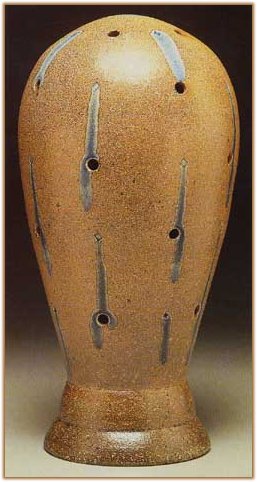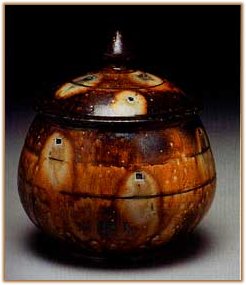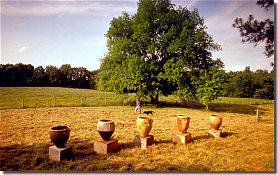|
Below Story Courtesy of Ceramics Art and Perception
Photos by Tim Barnwell; Written by Robert Yellin
The following article appeared in the excellent ceramic magazine Ceramics Art and Perception, Issue #50. Click here to visit their web site (opens new window). I rarely write about non-Japanese potters yet there is something about Hewitt's work, and the man himself, that is of the highest level. I enjoy using his work as much as I do some of the greats here in Japan -- particularly his beer mugs! You can visit Mark Hewitt's web site by clicking here (opens new window).

"MARKING TIME"
By Robert Yellin
I've lived in Japan since 1984 and have held good pottery in my hands, and eyes, every single day since then. There is no immediate pressing need, or desire, on my part to look outside of Japan for ceramic inspiration. Some may label this as a bizarre example of Japanese xenophobia, but I am not Japanese.
In Japan, I am in a rapturous clay heaven, one where my daily ceramic encounters have taken my spiritual aesthetic senses to a higher level. In fact, I can tell much about the maker of a pot now just by looking at it; for the spirit of the maker is as important as the actual work itself and no amount of posturing, cleverness, or credentials can cloak a dishonest pot, or potter. As the Chinese philosopher Lao Tzu wrote back in the sixth century:
Pots are made out of clay
But the hollow space in them makes the essence of the pot
And the essence comes from an intangible something
In the spirit of the potter
Which he is able to blend
into all his knowledge of throwing, the glazing and the firing
So that every piece from his hand
is as much his own signature and his heartbeat
Only then will the pot be good, that is alive
And the more highly developed a potter is as a human being,
the better his pot
For there is no real beauty without character.
I have met many Japanese potters who understand this -- the power of emptiness in a pot. I also must admit I have not had contact with many potters outside of Japan. Yet, I have met one US-based potter whose life, and pots, would make Lao Tzu smile -- his name is Mark Hewitt.
What intrigues me about Mark's work is how he has found a 'spot' far from his birthplace, used local materials, in much the same way as Hamada Shoji did in Mashiko, to create a world that is distinctly his own, and at the same time so connected to local tradition. Hewitt's story has been featured in many publications so here what I would like to explore is something inside myself. Why is it that I connect so much with Hewitt's work as I do with so many fine Japanese pots?
The range of vessels I use everyday is broad, from a chopstick rest to a chawan, soy sauce pourers, tea pots yunomi, plates, rice bowls, sake cups, flasks, and vases. I even have a few small ceramic lucky gods -- one Bizen, the other Shigaraki -- on my computer monitor. What draws me to select a certain work is sometimes a reason beyond function and words.
|

Piece by Mark Hewitt
Wigstand, Salt Glaze, Blue Glass
|
|
A subtle dialog, like an evocative mist, arises in the empty spaces that Lao Tzu wrote about, and I listen. Of course, the pot has to be able to perform its work efficiently, but efficiency is not the main reason for selection -- I might as well choose to use a plastic cup. There is a presence in the piece that has a magnetic pull that I cannot ignore and I pick it up.
Hewitt's output is mostly in a different realm from what I require for my table -- I really have no need for his Iced Tea Ceremony Vessels, for instance. In fact, I don't think the Japanese would even understand the play on words. Here, a smaller yunomi is much more in tune with the environment and traditions. In the Southern USA, where Mark Hewitt makes his pots, and where iced tea is imbibed, an iced tea ceremony vessel is a refreshingly appropriate conception, and, hopefully, will instill in the user a sense that what they are involved in when drinking iced tea on their front porch; it is no less sacred than the a tea ceremony created in Rikyu's tea hut. There is a consciousness in that cup like that of a Chojiro chawan, and Hewitt has taken it from Japan and replanted that spirit in North Carolina. One day I'd love to sip a cool mint julep from a Hewitt cup on some grand Southern USA front porch -- I might even close my eyes and think I am in Kyoto.
In May, 2002, Hewitt had his debut exhibit in Japan at Yufuku Gallery in Tokyo. One elderly Japanese gentleman walked in and was taken aback at how much more mingei (folk) the pots were than Leach's. We can label Hewitt's work any way we wish -- the fact of the matter is that wordy knowledge often interferes with understanding a work -- sometimes it is better to see with a silent mind. Yet in print I do have to use words, and this is what I wrote about Hewitt's pottery in my Japan Times column:
Hewitt's' works, and his words, are crafted with the utmost care. His pots are well-designed, thoughtful, confident, without being obnoxious; pleasing to the eye and well-suited to the table.
|

Mark Hewitt, Salt Glaze, Blue Glass, Swankalokk Jar
|
|
Reconsidering regional ceramic traditions, and specific items within those traditions, is nothing new. For instance, Kaneshige Toyo in Bizen, Arakawa Toyozo in Mino, Hamada Shoji in Mashiko, all revitalized particular regional Japanese styles of pottery. Michael Cardew's English slipware might also be thought of as fitting into this type of ceramic reappraisal. We now find Hewitt doing the same with North Carolina's tradition and, in the last few years, he has been examining some of the more unusual items within the tradition, in this particular case, grave markers.
North Carolina's folk potters have a heritage of making ceramic grave markers. A cursory search of the internet unearthed some interesting ceramic grave markers made in the early 1860's by Don Cagle, among others. Hewitt writes:
Adapted from 19th Century North Carolina ceramic grave markers, my Markers are a homage to the quirky, abstract forms made by folk potters as inexpensive alternatives to carved headstones. Given license to express the void, these potters veered from their classical functional repertoire to produce objects of stark singularity. This series of Markers explores the formal and emotional complexity of these obscure and challenging objects, and, while acknowledging the morbid, I offer them, rather, as affirmations of the pulse of life, and as vibrant reminders of the passage of time.
|
Piece by Mark Hewitt
Ash Glaze, Blue Glass
Tall Grave Marker
Potter Mark Hewitt |
|
There is a fascinating book of Japanese death poems (the title is just that) penned by Haiku poets and Zen monks on their deathbed. They had lived their lives fully due to their willing acceptance of the 'great leveler,' (from the Epic of Gilgamesh). Their poems are poignant gifts to me reminding me that every action I do is sacred and important. A good pot can help bring that state of 'now consciousness' into the present moment but a grave marker reminds me of something even more profound. It reminds me of the illusion of time and how also one day I may experience "Evening cherry blossoms; I slip my inkstone back into my kimono, this one last time." This is the divine power of presence instilled in Hewitt's poetic Markers.
When I saw one of his darker grave markers it was so full of energy, almost alive with angelic images, while another had sunbursts around the shoulder -- they were visual haiku. They would suit a Japan temple and therein lies another reason for my connection to Hewitt's grave markers -- they cross borders easily.
The same is true of the man, and the rest of his work as well. Hewitt's pots go beyond time and borders and into a world of timeless beauty intertwined with function for the 'simple' routines of daily life. There is much of Japan in those sentiments, and that is why I am very pleased to write about of Mark Hewitt's ceramics.
Robert Yellin is an art critic living in Japan who writes for the Japan Times. Mark Hewiit will be an invited guest at Ignition, The 10th National Australian Ceramic Conference to be held in Bendigo, April,2003. Above Photographs by Tim Barnwell.

Image for Hewitt's 2002 Exhibition at Yufuku Gallery in Tokyo
Photo courtesy Yufuku Gallery. Click above photo for larger image
Click Below to Learn More about Mark Hewitt
|